You never want insects inside your home; nonetheless, insects living and feeding on your wood.
This is exactly what old house borers do. They invade your home and damage your wood and furniture. The worse part is they are hard to identify because they live inside wood.
So how do you find them and get rid of them?
Don’t worry; I’m here to help.
In this post, I will tell you everything you need to know about identifying and getting rid of old house borers.
Let’s dive in.
Old House Borer Identification
What Do Adult Old House Borers Look Like?
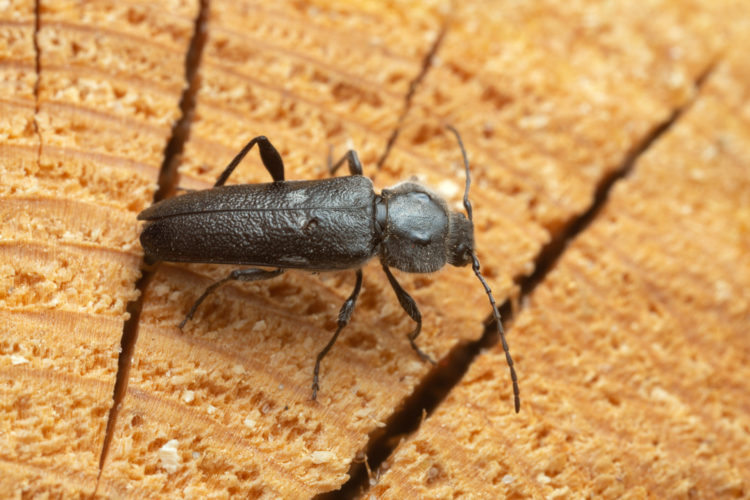
- Size: Adult old house borers measure between ⅝ and 1 inch long.
- Color: Dark brown to black beetles with
- Antennae: Long antenna about ⅓ of their body without any clubs
- Hair: Small faint white hairs on the body and more abundant patches of white hair on the head
- Pattern: Faint grey pattern on the beetle’s wings. The pattern is subtle and across the center of the old house borer’s body.
- Shape: Long, flattened, oval shape
- Other Features: Two shiny black knobs on the pronotum or area just behind their head
What Do old house Borer Larvae Look Like?
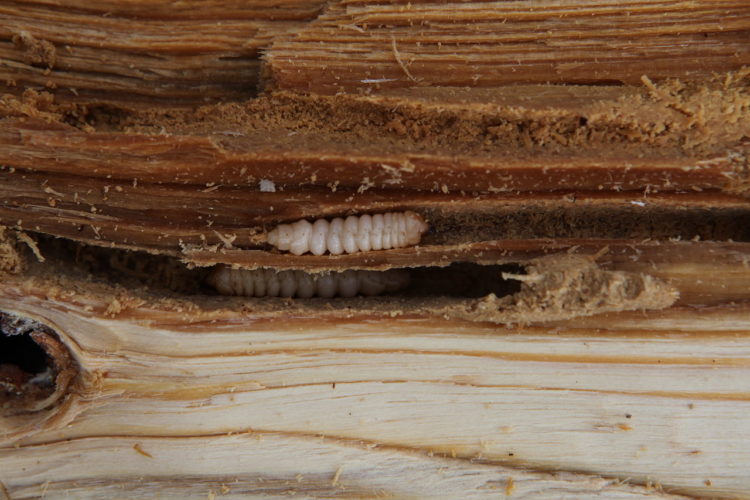
- Size: Larvae can grow up to 1 inch long
- Color: white or off-white with a black tip due to the dark mandibles
- Identifier: tiny dark eyespots in a vertical row on either side of their mandibles. These markings are only visible with a magnifying glass.
- Body: Worm-like body with segments
Where Do Old House Borer Beetles Live (Distribution)?
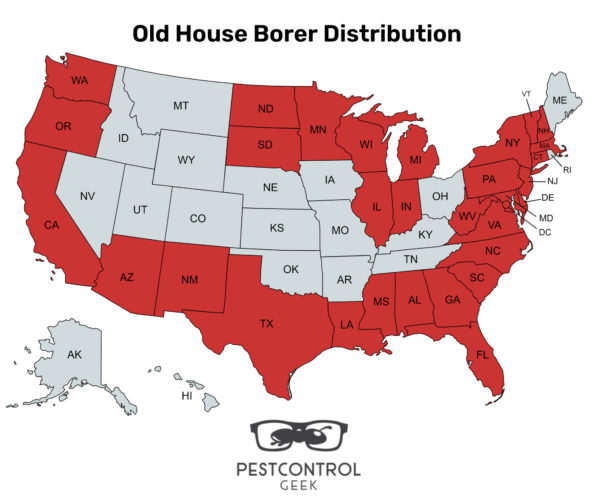
Old house borer beetles are found along with the coastal states from the East Coast to the West Coast. They are particularly prominent from Louisiana to Massachusetts in the East Coast and on the West Coast; they are common from Washington to Texas.
Old borer beetles are common in these states due to the high humidity and more likely hood that there is wood with sufficient moisture for them to survive.
Old House Borer Life Cycle
The adult old house borer typically emerges from wood between June and August. Males and females spend most of their life trying to reproduce and find a proper location to lay their eggs.
After laying the eggs in small cracks and crevices on wood, the larvae will begin boring into the wood.
After boring into their wood, they can stay inside the wood for between 3 and 15 years. In ideal conditions where there is sufficient moisture in the wood and no extreme heat, the old house borer will stay inside wood for shorter periods. When conditions are not ideal, they will stay inside the wood longer.
On average, old house borers will stay inside wood for between five and seven years.
After they are ready to pupate and become adults, they will bore close to the surface of the wood. This will allow the adults to easily chew through the wood and emerge as adults leaving distinct holes behind.
Old House Borer Damage
Old house borer infestations are often hard to identify because they don’t leave many signs behind.
One of the only ways you can identify if they are infesting your home is by inspecting your home for damage.
Since old house borers live inside wood, you want to inspect any wood items you have for damage. Since they live inside wood, inevitably, they will eventually leave damage behind that you can use to identify infected areas around your home.
Below are some of the key signs of damage by old house borers
- Small holes on your wood
- Galleries on wood
- Hollow wood
- Damage tends to occur closer to the surface because the protein content is the highest
Old house borer damage is typically localized to small areas since it takes a long time for them to spread.
Damage is the most common in areas with high humidity or areas with water damage.
Typically, well-ventilated areas and have low humidity levels will rarely experience old house borer infestations.
Signs of Old House Borer Infestations
Old house borers tend to target softwood or wood high in moisture. You want to inspect the wood around your home.
Below are signs that you might have old house borers:
1. Small Holes on Wood
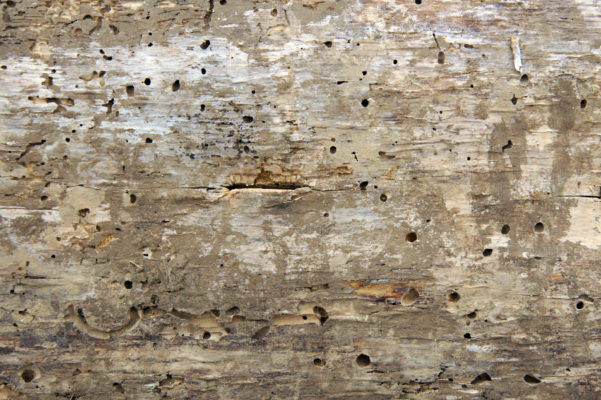
One of the easiest ways to identify a wood house borer infestation is the small holes they leave when they exit the wood.
These holes are small distinct holes on the wood. They measure between ¼ and ⅜ inch wide and are oval, and typically have jagged edges.
The most likely place you will find these holes on unfinished wood or high humidity areas such as basements and attics.
Other likely areas include wood that is water damaged or worn down by the environment, such as fascia boards or eaves.
2. Saw Dust or Wood Shavings
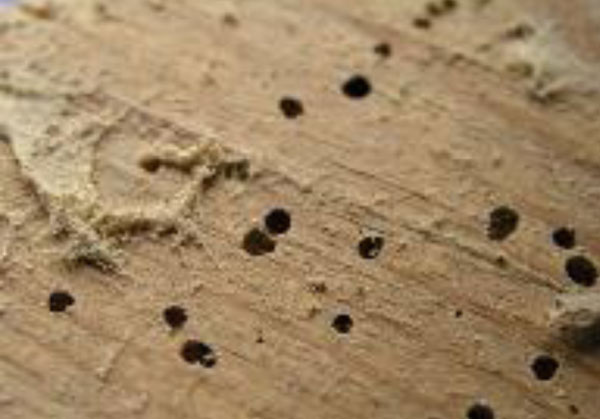
Another sign of wood house borers is sawdust or wood shavings. This sawdust is typically compared to the wood shavings left behind by termites or other wood-boring insects.
The sawdust might be located on the floor or on other pieces of wood. If you find sawdust, this typically means there is an exit hole on the wood around the sawdust.
You can use sawdust as a way to determine if the infestation is new or old. If exit holes have sawdust, then this means the infestations are new. If the exit holes don’t have sawdust or they are full of cobwebs or dust, this is a sign that the exit holes are old.
3. Tunnel or Galleries
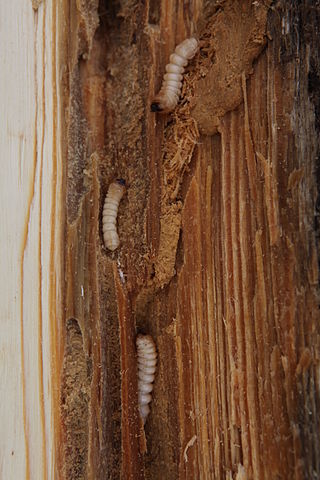
Old house borers typically leave rippled galleries or tunnels on wood. In contrast, it’s difficult to find tunnels or galleries because they are inside the wood.
Old house borers tend to create their tunnels near the surface of the wood because the wood here is high in protein for the larvae. You can inspect your wood and even consider pushing down on the wood to see if there are any loose portions that allow you to make out the galleries.
4. Weird Sounds or Larvae feeding
Another sign of an active house borer infestation is weird noises coming from your walls or furniture.
This is the sound of the larvae feeding and chewing on your wood.
They produce a sound that is similar to a rasping or cramping action. This sound is caused by the mandibles of the larvae scraping against the wood.
You are more likely to hear these sounds at night when it’s very quiet. Or when the larvae are feeding on wood that is close to the surface. If the larvae are deep in the wood, you likely won’t hear these sounds.
These sounds also become more noticeable as the larvae mature and are close to becoming an adult.
How Series are Old House Borer Infestations?
Old house borers are not a serious threat to a building’s structural integrity. This is because they stay embedded in wood for years. Typically, with one generation of old house borers, the damage won’t be severe.
In many cases, they also don’t spread very effectively and stay in a localized region.
Overall, old house borers are not dangerous to your structure, but they should be eliminated as soon as possible to reduce the damage they cause to your home.
If not addressed for long periods, especially in wood-damaged wood, this can cause structural damage.
How To Prevent Old House Borer
You can take a few simple steps to prevent old house borers from infesting the wood around your home.
Below are some steps you can follow:
- Use lumber that is pre-treated or kiln-dried. This will make the wood undesirable and uninhabitable for old house borers.
- Store any lumber wood or firewood properly to prevent water damage or excess moisture.
- Make sure all wood has a moisture level below 12%.
- Ensure proper ventilation to eliminate excess humidity.
- Apple polyethylene around any soil that comes into contact with wood.
- Reduce humidity in key areas around your home.
- Ensure there are no leaks or areas of water damage around your home.
- Apply sealant or protective layers to unfinished wood to prevent water damage or chewing by house borers.
How To get Rid of Old House Borers
1. Remove and Replace The Wood
As the name suggests, wood replacement involves replacing the infested wood.
Wood replacement is ideal if the infestation is only on a few pieces of wood.
If so, you can remove and replace the wood to get rid of the old house borer in your home.
After replacing the wood, I recommend you treat the new wood to prevent the old house borer from coming back.
You can do this by applying a layer of termiticide or bora-care to all sides of the area of the new wood.
Keep in mind, if the infested wood is load-bearing, you must consult with a professional first.
If you cannot replace the wood, then applying other localized treatments might be better for you.
2. Heat Treatment
Localized heat treatment has been shown to eliminate 98% of old house borers in the infested areas.
It involves heating infested wood above 120°F, which is fatal to old house borers.
Heat treatment is an excellent option if you’re looking to treat your home without using chemicals.
Similar to cold treatment, heat treatments require hiring professionals, which can be expensive.
But, unlike liquid nitrogen, heat treatment is offered by most pest control companies.
3. Treat Your Wood
Bora-Care is one of the most effective products used to prevent and control old house borer infestations.
Once absorbed, Boracare will stay on the wood for its lifetime as long as it is sealed and coated.
What You’ll Need
- Bora-Care
- Pressurized Sprayer
- Marking Dye
- Handheld drill
- Drill Bit 7/64 inch or large depending on your injection tip.
- Fine Tip Noozel for Injection
Instructions:
1. For Exposed or Unfinished Wood
Dilute five gallons of water for every one gallon BORA-CARE.
Next, add a marking dye to the solution. The dye will make it easier to keep track of where you’ve sprayed your solution.
Mix the solution and add it to a pressurized sprayer.
Apply even coats of bora-care to all sides of exposed wood.
For the best results, apply two coats of the bora-care solution.
Seal or coat the wood to finish treating your wood.
2. Painted or Finished Wood
To apply bora-care to painted wood, you’ll need to drill and inject the solution into the wood.
The process of preparing the Bora-Care is the same as for unfinished wood.
The only difference is you wouldn’t have to use a dye in the solution.
Next, drill holes 6-8 inches along the center of the wood you want to treat.
Inject the Bora-Care solution with the fine tip nozzle for 2-5 seconds into each hole.
When using Bora-care, always wear safety equipment, including gloves, masks, long clothing, and goggles.
4. Fumigate Your Home
Fumigation is a highly effective, difficult, and expensive treatment against old house borers. Typically fumigation is only necessary if infestations are large and other treatment options such as wood replacement are not possible.
Studies show that fumigation can eliminate up to 97% of wood-boring insects.
Fumigation requires professional exterminators to cover your home and release toxic gases inside.
These fumigants will absorb into the wood both inside and outside your home. The fumigant will suffocate both adult and larvae old house borers.
This process typically takes between 3-5 days to complete. The first two days are reserved for releasing the fumigant and allowing it to exterminate the infestation.
The remaining days allow your home to air out and destroy any harmful gasses from your home. This can take between one and three days.
One major upside to using fumigation is that it does not leave any harmful residual effects. Once the gas dissipates, there are no residual chemicals left behind.
5. Apply Insecticide Around Your home and Garden
Unfortunately, applying insecticides is not an effective way to eliminate old house borers that are already inside your wood.
You can apply insecticides to your garden and on the exterior surface of your house or any wood structures.
This eliminates any adult old house borers that are flying around and living outside your home.
If they land on your home, they will die, and when the eggs hatch and come in contact with the insecticide, they should die shortly after as well.
Spraying the exterior wood that is already infested will not absorb the insecticide and kill the larva inside.
To effectively apply insecticides inside the wood, you would need to insect the wood with insecticide, and this involves drilling holes into sections of the wood.
6. Seal and Protect Your Wood
Old house borers cause most of their damage because their larva feeds on wood.
One of the most effective ways to get rid of powder post beetles is to seal your wood. Sealing your wood will provide a protective layer on the outside of your wood.
This will make it harder for the powderpost beetle larva to burrow into your wood.
One of the first things you can do to get rid of powder post beetle is to seal the wood. Sealing the wood will provide a protective layer to the wood.
This will make it harder for common powder post beetle to burrow inside the wood. By sealing the wood, you also reduce the number of places where adults can lay their eggs.
By sealing up the cracks ad crevice, there will be fewer spaces to hide their eggs.
Also, if the wood is harder to penetrate, the larva is more likely to die after they hatch because they can’t burrow into the wood.
To seal your wood, you can take several steps
- Apply a fresh coat of pain
- Apply a varnish
- Stain your wood
- Apply a sealant
7. Reduce Moisture
Old house borers are more likely to infest areas with high humidity.
The high humidity produces an ideal environment for larvae to survive and boor into the wood.
High humidity also increases the chances that the wood around your home might begin decaying or experience water damage.
One way to reduce the humidity inside your house is to use dehumidifiers. This will help keep the moisture levels down.
Likewise, you want to inspect and make sure that there are not any drainage issues inside or outside your home.
This includes any potential leaks or puddles that form inside or outside your home.
Key areas you want to inspect include:
- Bathrooms
- Kitchens
- Attics
- Basements
- Boilers romance
- Laundry rooms
These rooms are the most likely to experience water damage or high humidity.
